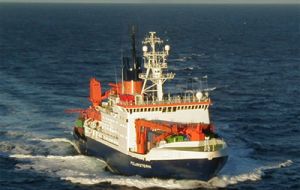MercoPress. South Atlantic News Agency
Voracious crustaceans terminate Antarctic waters fertilization experiment
 German flagged RV Polarstern
German flagged RV Polarstern A controversial geo-engineering experiment that Greenpeace campaigned against has concluded, and researchers say their findings deal a major blow to the geo-engineering technique known as ocean fertilization.
The Indo-German project Lohafex dumped 20 tons of iron sulfates in the ocean near Antarctica in an effort to spur enormous blooms of phytoplankton, a type of algae; researchers theorized that when that plant life died and sank to the seabed it would lock away the carbon dioxide it had absorbed while growing. They hoped that widespread use of this technique could slow global warming.
While the iron did prove an algae bloom, researchers involved in the project found that little biomass sunk down to the sea floor. Their results, announced in a press release suggest that iron fertilization could not have a major impact, at least in that region of the oceans.
“There’s been hope that one could remove some of the excess carbon dioxide - put it back where it came from, in a sense, because the petroleum we’re burning was originally made by the algae,” said [researcher] Victor Smetacek…. “But our results show this is going to be a small amount, almost negligible”.
Researchers also announced the surprising reason for that result: The plankton bloom wasn’t a carbon sequestration hot spot instead it was an all-you-can-eat marine buffet.
Within two weeks of the iron sulfide dump, the algae were being eaten by tiny creatures called copepods, which were then in turn eaten by amphipods, a larger type of crustacean. The researchers say that previous fertilization experiments that showed more sequestration impact generated a different type of algae known as diatoms, which are protected from grazing beasties by hard shells made of silica.
But the Southern Ocean has low levels of silica acid, which is necessary for the growth of diatom shells. “What it means is the Southern Ocean cannot sequester the amount of carbon dioxide that one had hoped,” concluded Professor Smetacek.
The project was sponsored by India’s National Institute of Oceaonography and the German Alfred Wegener Institute together with scientists from five other countries. The vessel used for the research was German flagged RV Polarstern.
The ocean iron fertilization two and a half month experiment in the south-western Atlantic covered a patch of 300 square kilometer patch of ocean inside the core of an eddy (a clockwise rotating water column with an area of about 10,000 square kilometers) with six tons of dissolved iron.
The effects of the fertilization on the plankton were followed continuously for 39 days. Additionally the project investigated ocean chemistry, particularly concentrations of CO2 and other greenhouse gases.
On 17 March the scientists returned to Punta Arenas, Chile and this week made public the results of the project.




Top Comments
Disclaimer & comment rulesCommenting for this story is now closed.
If you have a Facebook account, become a fan and comment on our Facebook Page!